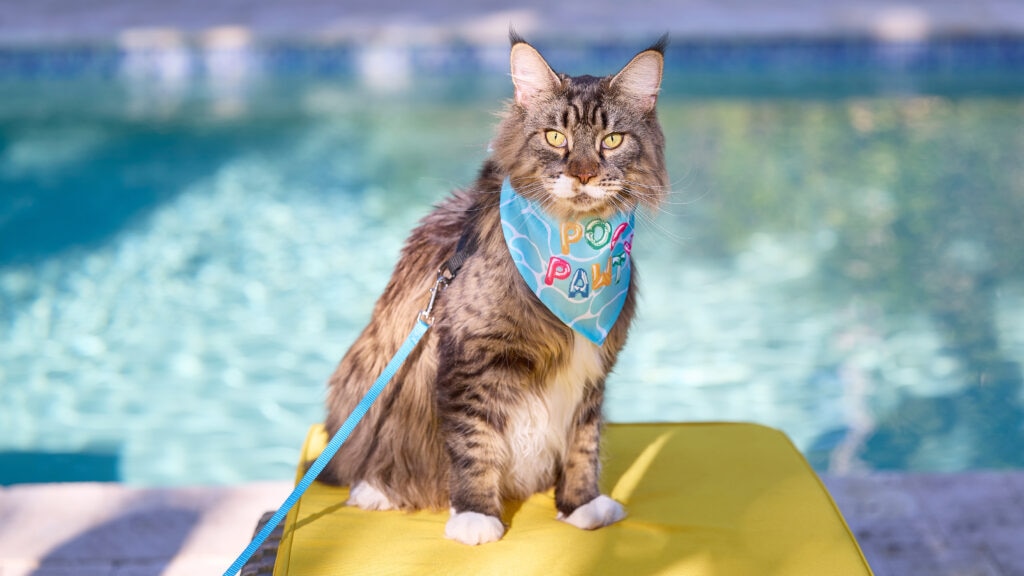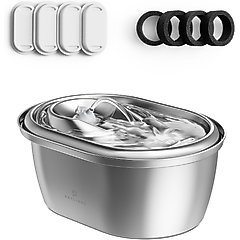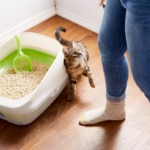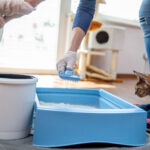How Hot Is Too Hot for Cats?

Photo by Chewy
Cats love to sprawl in sunny spots, but when temperatures soar, even the most summer-loving feline can overheat. While they generally handle warm weather better than dogs, cats can still develop heat-related issues like dehydration or heatstroke, especially if they don’t have a cool place to retreat.
So, how hot is too hot for cats? It depends on a few factors, including the temperature itself, the humidity level, and your cat’s overall health.
Here’s how to know when it’s too warm for comfort and what you can do to keep your cat safe.
How Hot Is Too Hot for a Cat?

Photo by Chewy
There’s no single temperature that’s too hot for every cat, but there are some general guidelines to follow.
Indoor cats are typically comfortable between 65–80 F, but once temperatures climb past that, it’s time to be cautious.
Humidity plays a role too. Cats cool down through panting: They pull moisture from their lungs and release it into the air where it evaporates. When it’s humid, the air is already moist, and this evaporation is less effective, according to Elizabeth Moses, DVM, ER veterinarian at VEG ER for Pets in South Tampa, Florida.
Because of this, be mindful of the overall climate, not just the specific temperature. A lower temperature with high humidity (for example, 85 F and humid) can be just as dangerous as 100 F with low humidity.
Here’s a quick guide to what’s safe and what’s not:
| Temperature | Is It Safe? | What To Know |
|---|---|---|
| Below 80 F (27 C) | Yes | Most indoor cats are comfortable between 60–80 F (15–27 C). |
| 80–99 F (27–37 C) | Be cautious | Indoor cats may overheat if exposed too long. Outdoor cats may tolerate it better, but risk still increases. |
| Above 100 F (38 C) | Too hot | Keep cats indoors. Prolonged exposure can lead to heatstroke or dehydration. |
Keep in mind that a cat’s natural body temperature is higher than a human’s—usually between 100–102.5 F. Because of this, they can be more comfortable at a slightly higher temperature than you might be.
Do Cats Like Hot Weather?
But do cats actually like hot weather? Yes and no.
Some cats like the heat within reason. That’s because the ancestors of domesticated cats lived in the desert, so they’re adapted to warm temperatures, says Jennifer Coates, DVM, a veterinary consultant based in Fort Collins, Colorado, and author of several veterinary books.
But cats don’t like extreme heat, and most prefer having options: a sunny window when they want it and a cool, shady retreat when they don’t, for example.
Still, even if your cat seems like they’re enjoying the heat, you want to make sure you’re not letting them get too hot.
What Is the Ideal Temperature for Cats?
So, what’s the sweet spot? For most cats, between 65–75 F is ideal.
If the temperature climbs above 80 F, especially without fans or airflow, keep a closer eye on them.
Which Cats Are Most Sensitive to Heat?
But while these are general guidelines, not every cat handles heat the same way. Some are more prone to overheating than others.
Watch your cat carefully in hot weather if they:
- Are a flat-faced (brachycephalic) breed: Flat-faced breeds, like Persians or Himalayans, have shorter nasal passages that make it harder for them to cool down. This makes them less efficient at regulating body temperature, says Dr. Moses.
- Are overweight: Overweight cats have extra body fat that acts as insulation, making it harder for their bodies to release excess heat.
- Are a kitten or senior cat: Very young kittens and old cats don’t regulate body temperature as well as healthy, adult cats. They can also be more susceptible to the effects of minor changes in body temperature, says Dr. Coates.
- Have a chronic health condition: Cats with heart, kidney, or respiratory conditions are more vulnerable to heat-related issues, according to Dr. Moses. These conditions can make it harder for their bodies to circulate blood, cool down, or handle even mild dehydration.
- Have a thick or dark coat: Thick, dark coats can absorb or produce more heat, according to Dr. Coates. These cats may start to overheat more quickly, especially if they spend time in direct sunlight or warm, unventilated rooms.
- Are indoor-only: Indoor cats can be more sensitive to temperature changes. Because of this, an indoor cat who’s used to living in an air-conditioned home may run into more problems if they get outdoors during the summer than an outdoor cat who has been exposed to similar temperatures many times before, says Dr. Coates.
What Happens When Cats Get Too Hot?
This isn’t just about comfort: When a cat overheats, their body can’t regulate temperature efficiently, and that can lead to some serious health problems.
Proteins break down, cells lose the ability to produce energy, and the blood clotting system goes haywire, says Dr. Coates. When this happens, it can lead to multiple organ failures, permanent brain damage, and even death without rapid and aggressive treatment.
There are different levels of overheating, from heat exhaustion to heatstroke. The sooner you’re able to identify an issue, the better the potential outcome.
Heat Exhaustion
Heat exhaustion is an early stage of heatstroke that develops when a cat’s body temperature reaches 103–104 F.
Some signs of heat exhaustion include:
- Lethargy or acting unusually tired
- Excessive grooming
- Panting or rapid breathing
- Seeking out cool surfaces to lie on
- Slight drooling or dampness around the mouth
- Reduced appetite
- General discomfort/restlessness
Heatstroke
Heatstroke is a more serious form of overheating. It occurs when a cat’s body temperature climbs to 105 F (or more) and the cat can no longer cool themself off on their own.
Signs of heatstroke include:
- Rapid breathing
- Dry red or purple gums
- Drooling
- Vomiting
- Diarrhea
- Seeking cool spaces
- Unexpected bleeding or bruising
- Confusion
- Unsteadiness
- Muscle tremors
- Weakness
- Lethargy
- Seizures
- Collapse
Dehydration
Dehydration happens when a cat loses more fluids than they take in, usually through panting, grooming, and/or not drinking enough water. It can happen on its own or alongside heat exhaustion and heatstroke, especially during hot or humid weather.
Some signs of dehydration in cats include:
- Dry or tacky gums
- Loss of appetite
- Panting
- Sunken eyes
- Lethargy
- Poor skin elasticity (if you gently pinch the skin at the scruff and it doesn’t snap back quickly)
- Increased heart rate
If you see any of these signs:
- Move them to a cooler environment.
- Give them cool (but not cold) water.
- Call your vet immediately.
If you see signs like panting, wobbliness, or collapse, bring your cat to an emergency vet immediately, Dr. Moses says.
How To Keep Your Cat Cool
Because overheating can be so dangerous, it’s important to take steps to help keep your cat cool when the weather heats up. Here are a few easy ways to do that:
- Move your cat to a cool spot.
- Run fans, like the XPOWER FM-48, or air conditioning to try to maintain an indoor temperature of 65–75 F.
Recommended Product
- Make sure fresh, cool water is available at all times. Consider a stainless-steel fountain, like this one from Petlibro.
Recommended Product
- Keep blinds or curtains closed during peak sunlight (usually midday to early afternoon)
- Place a cooling mat, like The Green Pet Shop Cool Mat, near areas your cat likes to spend a lot of time.
Recommended Product
- Swap dry food with wet food for added hydration.
- Avoid leaving your cat in sunrooms, garages, or other poorly ventilated spaces.
FAQs About How Hot Is Too Hot for Cats
Q: How hot is too hot for cats outside?
A: Once temperatures climb above 90 F, it can be too hot for cats to be outside safely, especially without access to shade or water. Dr. Coates says temperatures of 100 F or more can be especially problematic.
Q: How hot is too hot for cats indoors?
A: Indoors, anything over 80 F should be watched closely, especially in rooms with little airflow. Indoor cats can be more susceptible to heat and changes in temperature since they’re not used to it.
Q: What temperature should I keep my house for my cat?
A: There’s not one magic temperature, but 65–75 F is comfortable for most cats. If you can, keep your house within this range.
Q: Can fans or AC help cats stay cool?
A: Yes, fans and AC can help cats stay cool. Fans can help promote airflow, while the AC can be a lifesaver during extreme heat.






